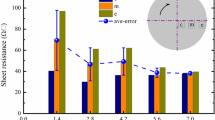Abstract
We investigate the effect of the flow rate of oxygen and hydrogen gases on the characteristics of OLEDs (organic light emitting diodes) with Al-doped ZnO (AZO) anodes. The AZO thin films are deposited by radio frequency (RF) magnetron sputtering under different ambient gases (Ar, Ar + O2, and Ar + H2) at 300°C. To investigate the influences of the ambient gases, the flow rate of oxygen and hydrogen in argon was varied from 0.1 sccm to 5 sccm. The AZO thin films were preferentially oriented to the (002) direction regardless of the ambient gase used. The electrical resistivity of the AZO thin films increased with increasing O2 flow rates, whereas the electrical resistivity decreased sharply under an Ar + H2 atmosphere and was nearly the same regardless of the H2 flow rate used. The change of electrical resistivity with changes in the ambient gas composition was mainly interpreted in terms of the charge carrier concentration rather than the charge carrier mobility. All the films showed an average transmittance of over 85% in the visible range. The optical band gap of the AZO films increased with increasing H2 flow rates, whereas the optical band gap of the AZO films deposited in an O2 atmosphere decreased with increasing O2 flow rates. The current density and the luminance of the OLED devices with AZO thin films deposited in 5 sccm of H2 ambient gas were the highest among all the films. The optical band gap energy of AZO thin films plays a major role in OLED device performance, especially the current density and luminance.
Similar content being viewed by others
References
K. Tominaga, T. Ueda, T. Ao, M. Kataoka, and I. Mori, Thin Solid Films 281–282, 194 (1996).
Y. Hoshi, H. Kato, and K. Funatsu, Thin Solid Films 445, 245 (2003).
K. K. Kim, H. Kim, S. N. Lee, and S. Cho, Electron. Mater. Lett. 7, 145 (2011).
N. Taga, M. Maekawa, Y. Shigesato, I. Yasui, M. Kamei, and T. E. Haynes, Jpn. J. Appl. Phys. 37, 6524 (1998).
C. N. de Carvalho, A. M. B. do Rego, A. Amaral, P. Brogueira, and G. Lavareda, Surface and Coatings Technology 124, 70 (2000).
X. Jiang, F. L. Wong, M. K. Fung, and S. T. Lee, Appl. Phys. Lett. 83, 1875 (2003).
J. Hu and R. G. Gordon, J. Appl. Phys. 71, 880 (1992).
F. K. Shan and Y. S. Yu, J. Eur. Ceram. Soc. 24, 1869 (2004).
D. Horwat, Thin Solid Flms 515, 5444 (2007).
W. Liu, G. Du, Y. Sun, Y. Xu, T. Yang, X. Wang, Y. Chang, and F. Qiu, Thin Solid Flms 515, 3057 (2007).
K. H. Yoon, J. W. Choi, and D. H. Lee, Thin Solid Films 302, 116 (1997).
N. Oka, K. Kimura, T. Yagi, N. Taketoshi, T. Baba, and Y. Shigesato, J. Appl. Phys. 111, 093701 (2112).
J. Jia, A. Takasaki, N. Oka, and Y. Shigesato, J. Appl. Phys. 112, 013718 (2112).
D. H. Hwang, H. H. Ahn, K. N. Hui, K. S. Hui, and Y. G. Son, J. Ceram. Proc. Res. 12, 150 (2011).
D. Xu, Z. Deng, Y. Xu, J. Xiao, C. Liang, Z. Pei, and C. Sun, Phys. Lett. A 346, 148 (2005).
X. T. Hao, L. W. Tan, K. S. Ong, and F. Zhu, J. Cryst. Growth 287, 44 (2006).
R. Das, K. Adhikary, and S. Ray, Appl. Surf. Sci. 253, 6068 (2007).
J. Tauc, R. Grigorovichi, and A. Vancu, Phys. Status Solidi 15, 627 (1966).
D. H. Oh, Y. S. No, S. Y. Kim, W. J. Cho, J. Y. Kim, and T. W. Kim, J. Ceram. Proc. Res. 12, 488 (2011).
Author information
Authors and Affiliations
Corresponding author
Rights and permissions
About this article
Cite this article
Han, SH., Jo, DB. & Lee, KM. Effect of the flow rate of oxygen and hydrogen gases on the characteristics of organic light emitting diodes with Al-doped ZnO anodes. Electron. Mater. Lett. 9 (Suppl 1), 43–48 (2013). https://doi.org/10.1007/s13391-013-3178-z
Received:
Accepted:
Published:
Issue Date:
DOI: https://doi.org/10.1007/s13391-013-3178-z




